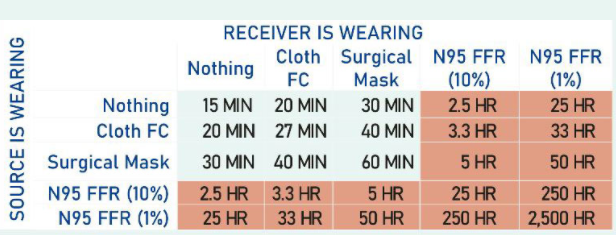A few days back, I posted this graphic that created quite some interest and confusion too. So, trying to put it together in more than 240 characters now - 🧵 1/ 

2) The original idea came from ACGIH, trying to stress the point that essential worker, beyond healthcare, also need better masks, better respiratory protection.
acgih.org/covid-19-fact-…
acgih.org/covid-19-fact-…

3) Their assumption was that if without masks, it takes 15 minutes for a vulnerable person to inhale enough virus loaded particles to get infected, under the same conditions, how much can masks delay this time needed to reach infectious dose.
4) Here, 15 minutes is a starting assumption. It is not a saying that 15 minutes is always what it takes. You just need to start from a point to build on it.
5) The other option would have been to use x, 1.5x, 2x, 10x etc, to stress that these are all relative risks. But, concrete numbers are easier for people to wrap their heads around than algebraic correlations, so I think the choice of minutes makes more sense.
6) So, just to reiterate, these are all evaluations of relative risks, i.e., if it took 15 minutes, without masks, how much could masks protect us more, under same conditions.
7) I took the idea and started with 10 minutes instead of 15 - by that time, it was well known that it can definitely take less than 15 minutes. I needed to start t some point and chose 10 minutes based on the Korean restaurant findings. doi.org/10.3346/jkms.2…
8) So starting from 10 minutes, for no masks, for the wild variant, we have some numbers for the different mask configurations.
For all masks, I am using the same protection for both inward and outward filtration, except for cloth masks.
For all masks, I am using the same protection for both inward and outward filtration, except for cloth masks.
9) For Surgical masks, I am using 50%, for surgical masks fitted with a brace, 80%, for N95 90% and fit tested N95 99%. For cloth masks, I am using 30% inward and 40% outward.
10) So, based on these assumptions and starting point, we arrive at this figure, while assuming that #Delta can be ~2.5 times more transmissible, mostly due to more viral shedding. 

11) The intention is not to provide you a number on how long you will be safe, but to help visualize how much risks increased with #DeltaVariant. Earlier, if fitted surgical masks were enough for you (~4.2 hours), now you may need respirators (~6.8 hours) \end
Redid the schema with X, instead of absolute times, just to reinforce the point that these are estimates of relative risks. Specifically, focus on what Delta did to our situation. 

• • •
Missing some Tweet in this thread? You can try to
force a refresh









